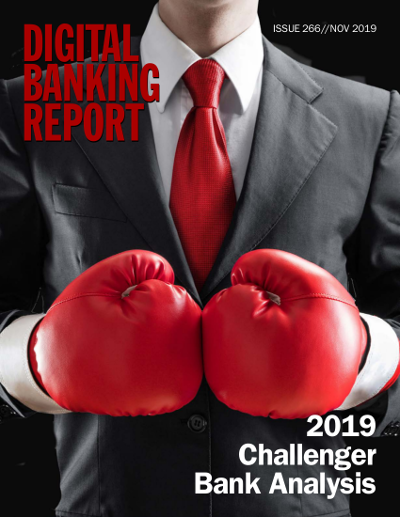2019 Challenger Bank Analysis
Jim Marous
November 2019
: DBR 266
88 pages, 22 tables/charts
Download Printable Version of this page
With a world that is becoming more complex, today’s consumer is seeking organizations that can simplify their lives in a manner that is both personalized and seamless. The fewer steps it takes to achieve any objective, the better. The consumer also is growing increasingly aware of what is possible with modern technology, and they are moving established relationships to those organizations that can provide the best overall experiences.
Most banks and credit unions have been unable to deliver a seamless consumer experience due to the continued presence of product and data silos, decades-old infrastructure, and a risk-averse culture that produces only incremental innovation. This has created an open door for startups and established non-financial competitors that can leverage data, modern technology and an agile mindset to deliver enhanced experiences.
Beyond accessorizing existing accounts, an increasing number of consumers are ditching their legacy banking relationships altogether. As some of the larger fintech organizations expand their product offerings and build consumer trust, more disintermediation away from traditional financial organizations will occur.
Banks, credit unions, non-traditional financial services providers, government agencies and big tech firms continue to debate what the banking ecosystem of the future will look like. Most believe that some sort of partnerships or collaborations will be needed to move forward successfully. The question is, which organizations will combine thought leadership and distribution capabilities to deliver next-generation solutions that will make the daily lives of consumers better?
More than ever, many traditional financial institutions believe fintech startups could be collaboration partners, short-cutting innovation efforts and providing enhanced digital solutions. But is the desire to partner coming too late? Evidence indicates that the strength of fintech firms and challenger banks may be greater than ever, providing some firms confidence that they can “go it alone.”
The World Retail Banking Report 2019 from Capgemini outlines the increasing acceptance of fintech and big tech offerings.
- 75% of tech-savvy consumers are currently using at least one financial product from a big tech provider.
- The top three reasons customers say they use non-traditional players are lower costs (70%), ease of use (68%), and faster service (54%).
- More than 80% of consumers likely to switch financial providers are currently using payments, cards, or banking account products from a big tech firm or challenger bank or are likely to do so in 3 years.
The question that needs to be asked is, “Can banks and fintech firms work well together”? As the challenger bank battlefield continues to become more crowded, traditional and non-traditional financial organizations will need to determine their position in the marketplace and whether the consumer can wait for their current legacy bank to catch up. I would like to thank Devie Mohan and her team at Burnmark for their assistance in the development of this important market analysis.
2019 Challenger Bank Analysis
Advanced Analytics, AI, Analytics, Artificial Intelligence, Bank, Banking, Big Data, Credit Union, CRM, Customer Experience, Direct marketing, Digital Assistant, Digital Banking, Digital Lending, Digital Marketing, Digital Transformation, Engagement, Fintech, Innovation, Marketing, Mobile Banking, Payments, Personalization, Technology, Trends, Voice Banking, Voice-First

